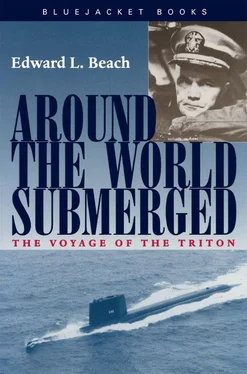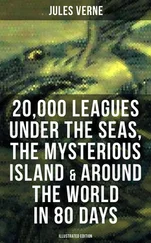There was a moment of concern early in the game when I realized that Lawrence W. Beckhaus might equate Triton ’s Buck column with a similar one in Salamonie’ s Bunker Gazette, but a sharp sally from Buck, in which Larry was admonished to keep his mouth shut, had, I supposed, the desired result.
Had one never experienced it before, the large share of our daily lives occupied by this little two-page newspaper might have appeared surprising. To me it was not, for I had seen the same thing before on long, uninterrupted cruises. The moment the ship gets to port, however, there is no further interest, and the ship’s newspaper may as well cease publication until you are once again at sea.
The highest point of the Triton Eagle’ s journalistic achievement was probably reached during our traverse of the Indian Ocean, when it published daily reports on an extended controversy involving a mythical “two-gauge goose gun.” Tom Thamm and Chief Petty Officers Loveland and Blair were arraigned on opposite sides of the argument, which ran for several issues, and everyone had a lot of fun with it.
From the Log:
Friday, 15 April 1960 0000 Out goes the smoking lamp, eliciting many unfavorable comments from the smokers, a great air of superiority from the nonsmokers.
All hands have been carefully briefed for some time as to the purpose of the test and how it is supposed to be run, but we have avoided giving any indication as to the intended length, stating only that the operation order prescribes it shall not exceed 10 days. Ben Weybrew tells me privately that it will not have to be nearly that long, but that he wishes to avoid any complications from anticipation of an early “relight.” In preparation for it LCDR Bob Fisher (SC) USN, [the only supply corps officer attached to and serving on board a submarine] has laid in a stock of candy and chewing gum. It is shortly discovered that some of the men had apparently also brought along a supply of chewing tobacco, which introduces an unforeseen variable into the experiment. Some of the volunteer subjects had neglected to mention their intention to chew tobacco in place of smoking during this period. It was noted, too, that cigars are at a premium since they can be cut into short lengths and chewed also.
Saturday, 16 April 1960 The smoking lamp is still out and the psychological reaction building up is surprising. Although I had not felt repressed by the atmosphere in any way previously, there is to me an indefinable but definite improvement to it. It feels cleaner, somehow better, and so do I. Will Adams agrees, being also a nonsmoker, but nobody else does. Tom Thamm announces that the limits of human endurance had been reached in the first 3 hours, so far as the smokers of the ship were concerned, and the remaining time of the test is purely a sadistic torture invented by Weybrew, Stark and myself.
Thamm is a tall very blond type whose meticulous and precise approach to everything conceals a highly developed artistic nature. He is Auxiliary Division Officer and, as such, works for Don Fears, our Engineer. Tom is in charge of most of the auxiliary systems and appliances throughout the ship, such as hydraulics, air conditioning, carbon-dioxide removal equipment, auxiliary diesel engine, main vent mechanisms and the like.
We have nearly crossed the Indian Ocean. Tomorrow, we expect to arrive at the Cape of Good Hope. It has been a pleasant trip, unmarred by submerged peaks or other alarms. The water is as uniformly deep as anywhere we have seen, not too cold, but cool and beautiful through the periscope. It is one of the least known oceans, bounded on the north by the subcontinent of India, on the west by Africa and on the east by the Malay Archipelago and Australia. Its southern boundary is Antarctica. One of its noticeable characteristics, at least so far as we have observed, is a consistently heavy sea condition, and in this it resembles the Atlantic. Every time we are at periscope depth for observations, it appears that a state 3 to 4 sea is running [corresponding to wave heights from 5 to 10 feet], enough to make surface ships uncomfortable.
A matter of note: LCDR Adams, now relieved from navigational chores, is concentrating full time on administrative matters, with intent of having desk cleared for the avalanche of paper work we expect upon arrival in the United States. There has been a steady flow coming out of his desk anyway, but since Lombok Strait it has tripled. And all of us dread the blizzard of paper awaiting us in New London.
So far as the no-smoking test is concerned, Weybrew and Stark contend that they have enough now to fulfill the requirement laid upon them by Medical Research Laboratory. It is also apparent, according to them, and I must confess having noticed something of the same myself, that the test has gone on just about long enough. Overt feelings of hostility are coming to the fore, expressed in a number of small ways, and there have been instances of increasing irritability. Deprived of a normal intake of mild stimulant, there obviously have been mild withdrawal symptoms among the heavier smokers in the crew.
The same is evident in the officers. Most noticeable, to me, are signs of forced gaiety, frequently with a sharp edge to it. Jim Stark, himself a heavy smoker, enjoys egging his wardroom buddies on—and this, in my opinion, is his compensation.
One night during this period, I recall asking the cause of a large red welt across the top of Jim’s baldish head. The explanation, given with suppressed mirth by his wardroom mates, was that an hour before he had been demonstrating his complete freedom from any reaction to the enforced abstinence from smoking by showing that his physical co-ordination had been unimpaired. The test he chose, hopping on one leg, might have been a good one had he taken the trouble to check his surroundings first. Without thinking, he hopped through the wardroom doorway and attempted to ram his head through the heavy aluminum beam which forms the top of the door frame.
From the Log:
These were expected manifestations of adjustment and are cause for no particular notice, but there are also one or two cases where evidence of heightened nervous reaction is accompanied by relatively poor adjustment. In a ship’s company of 183 people, something of this sort is bound to turn up. But answering my question as to what the ultimate results might be in the most severe cases, if the smoking lamp could not be relighted, the savants spread their hands expressively, “Who knows?” they say. “Most likely, if the man recognizes that it is impossible to smoke, he will psychologically adjust to it with relative ease. Symptoms will disappear or maladjustments will work themselves out.”
The point is that here in Triton the only reason for prohibiting smoking is for a test. Everyone knows it requires but one word, and the smoking lamp will be lighted. Were we in a dangerous situation where safety of the ship or life of personnel were involved, as for example in an explosive atmosphere, the entire situation would be different.
Easter Sunday, 17 April 1960 We are approaching the Cape of Good Hope. Many people will be surprised to learn that the Cape of Good Hope is not actually at the southernmost tip of Africa at all. This honor is reserved for Agulhas Point, a little more to the south. Agulhas is not, however, a prominent landmark like the Cape of Good Hope. The story goes that when a storm blew Bartholomew Diaz around the southern end of Africa, he saw nothing and actually went quite some distance northward on the east side of that continent. On his return voyage, he bestowed the name “Stormy Cape” on the most distinctive point of land in the area; it was King John of Portugal who thought of “Cape of Good Hope.”
Читать дальше












